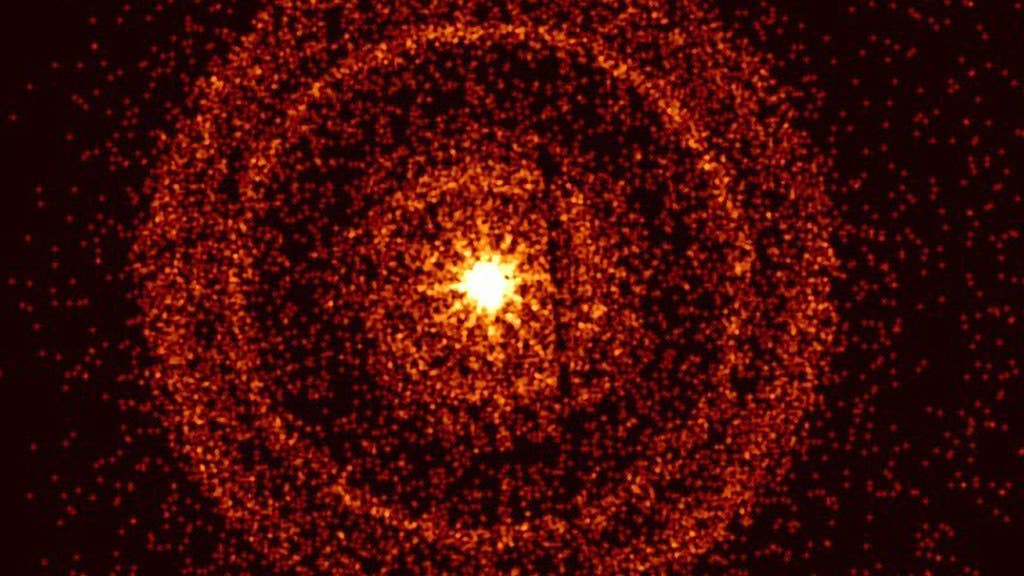Scientists discover what caused the brightest cosmic explosion of all time
Named as the Brightest of All Time due to its unprecedented luminosity, this explosion is the muse of astrophysicists around the world.

[Aug. 28, 2023: Staff Writer, The Brighter Side of News]
The afterglow of the Brightest of All Time gamma-ray burst, captured by the Neil Gehrels Swift Observatory’s X-Ray Telescope. (CREDIT: NASA/Swift/A. Beardmore (University of Leicester))
In the vast realm of outer space, where innumerable phenomena occur every moment, some events manage to stand out from the crowd. One such event, a cosmic explosion that occurred on October 22 last year, has since been the epicenter of global scientific intrigue.
Named as the Brightest of All Time (BOAT) due to its unprecedented luminosity, this explosion has become the muse of astrophysicists around the world, with many scrambling to fathom its underlying causes and unique characteristics.
The Cosmic Conundrum
Arising from the cataclysmic collapse of a supermassive star, which subsequently resulted in the birth of a black hole, the BOAT was characterized by a dazzling flash of gamma rays. However, what caught the attention of the global scientific community was the exceptionally gradual dimming of the afterglow across various frequencies. While similar events typically fade into obscurity relatively quickly, the BOAT seemed to defy this norm.
As telescopes from every corner of the planet simultaneously picked up the BOAT signal, the scientific race began. What caused this gamma-ray burst (GRB) to shine so brightly? Why did its afterglow take its time to fade?
Related Stories
Today, thanks to the relentless efforts of an international research team featuring Dr. Hendrik Van Eerten from the University of Bath's Department of Physics, we are a step closer to answering these burning questions. Their groundbreaking findings have recently been featured in the esteemed journal, Science Advances.
According to Dr. Van Eerten, a key contributor to the theoretical analysis of the event, the primary reason for the exceptional brightness of the BOAT was its direct alignment with our planet. "The jet was pointed directly at us – much like a garden hose angled to spray straight at you – and this definitely goes some way to explain why it was seen so brightly," he explained.
However, this revelation wasn’t the end. The absence of visible edges of the jet posed yet another puzzle. A significant discrepancy in the fading pattern of the afterglow signaled to the team that there was more to the story.
The extreme brightness of GRB 221009A. Top left: Histogram of gamma-ray fluence for Fermi (blue; 10 to 1000 keV) and BATSE (gray; 50 to 300 keV) GRBs compared to GRB 221009A. (CREDIT: Science Advances)
“Our work clearly shows that the GRB had a unique structure, with observations gradually revealing a narrow jet embedded within a wider gas outflow where an isolated jet would normally be expected,” Van Eerten further elaborated on the team’s findings.
Piecing Together the Puzzle
The team also proposed a potential reason for the expanded width of this GRB. As Dr. Van Eerten detailed, the jet, while forming, had to traverse through the collapsing star. The variable in this particular scenario was the degree of intermixing between the stellar material and the jet. This interplay ensured that shock-heated gas consistently appeared in our line of sight, effectively drowning out any distinct jet signature in the overarching emission from the afterglow.
Multiwavelength light curve of GRB 221009A. The XRT and XMM-Newton data represent the x-ray flux density at 1 keV, whereas the flux density from the NuSTAR observations is reported at 5 keV. (CREDIT: Science Advances)
Delving deeper, Dr. Van Eerten shared insights that expand beyond the BOAT, shedding light on prior GRBs that left astronomers puzzled due to their ambiguous jet signatures. “These GRBs, like other GRBs, must be directed straight towards us when they happen, as it would be unphysical for that much energy to be expelled in all directions at once,” he remarked.
He also hinted at the existence of a distinct category of events that are not only extreme but also successfully conceal the directed nature of their gas flow. He believes that upcoming research on the magnetic fields that instigate the jet and the mammoth stars that house them could uncover the reasons behind the rarity of such GRBs.
Schematic of the structured jet for GRB 221009A. Emission from the FS and RS are produced by the jet out to its truncation angle θs. The angular structure of the jet, EK/dΩ ∝ θ−a, breaks slightly at θb, transitioning from a slope a1 ∼ 0.75 to a2 ∼ 1.15. (CREDIT: Science Advances)
A Rare Glimpse into Cosmic Wonders
Adding to the conversation, the lead author of the study, Dr. Brendan O’Connor, who recently received his doctorate from the University of Maryland and George Washington University in Washington, DC, spoke of the unparalleled opportunity this event presents.
“The exceptionally long GRB 221009A is the brightest GRB ever recorded and its afterglow is smashing all records at all wavelengths. Because this burst is so bright and also nearby (cosmically speaking: it occurred at the minor distance of 2.4 billion light years from Earth), we think this is a once-in-a-thousand-year opportunity to address some of the most fundamental questions regarding these explosions, from the formation of black holes to tests of dark matter models,” he expressed with palpable excitement.
The BOAT, a cosmic spectacle like no other, has illuminated not just the sky but also our understanding of the universe. As scientists continue to unravel its mysteries, it stands as a testament to the unpredictable beauty of the cosmos and our ceaseless quest for knowledge.
Note: Materials provided above by The Brighter Side of News. Content may be edited for style and length.
Like these kind of feel good stories? Get the Brighter Side of News' newsletter.



